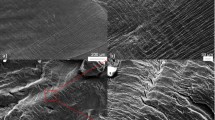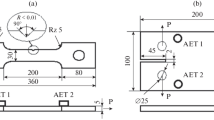Abstract
The application of acoustic emission to the detection of fatigue-crack propagation in 7075-T6 aluminum and 4140 steel is investigated. The relationship between crack-growth rate, cyclic stress-intensity factor, load-cycling rate and observed acoustic-emission behavior is presented. Crack-growth rates of less than 10−6 in./ cycle could be detected, and acoustic-emission counts per cycle were shown to be closely related to the energy released by crack extension per cycle. A quantitative relationship for the threshold conditions for detection of fatigue-crack growth is presented which agrees with experimental test results. The results also showed that fatigue-crack growth occurs in an accelerating and decelerating manner, even though the stress-intensity range remains uniform, and that the count rate posses through a peak that is believed to be associated with a plane strain-plane stress transition. The effects of instrumentation sensitivity and frequency bandpass are also investigated. The results obtained indicate that acoustic-emission techniques should be suitable for in-service monitoring of a variety of cyclically loaded structures, even in the presence of high background noises.
Similar content being viewed by others
Abbreviations
- A :
-
crack area
- a :
-
crack length
- a′ :
-
crack-growth rate (=da/dn)
- B :
-
specimen thickness
- C :
-
proportionality constant
- D :
-
proportionality constant in crack-growth relation
- E :
-
modulus of elasticity
- G :
-
amplifier gain
- G :
-
strain-energy release rate
- K :
-
stress-intensity factor
- \(\hat K\) :
-
stress-intensity range (=K max-K min)
- N :
-
acoustic-emission counts
- N′ :
-
acoustic-emission count per cycle (=dN/dn)
- n :
-
number of fatigue cycles
- n :
-
cyclic-loading rate
- n f :
-
cycles to failure
- P :
-
load
- \(\hat P\) :
-
load range (=P max-P min)
- R :
-
load ratio (=K min/K max=P min/P max)
- t :
-
time
- t * :
-
time for amplified sensor signal to ring down below trigger level of counter
- U :
-
energy released by an event
- V :
-
voltage of amplified and filtered acoustic-emission signal
- V o :
-
initial voltage of acoustic-emission signal due to a single event
- V t :
-
minimum voltage required to trigger the counter
- Y :
-
term in equation for stress-intensity factor
- α:
-
a/w
- β:
-
time constant of exponential decay of sensor signal
- η:
-
number of counts from a single event
- σ ys :
-
yield strength
- ω:
-
frequency of acoustic-emission signals
References
Acoustic Emission, ASTM Special Tech. Pub. No., 505 (1972).
Gerberich, W. W. and Hartbower, C. E., “Monitoring Crack Growth of Hydrogen Embrittlement and Stress Corrosion Cracking by Acoustic Emission,” Proc. Conf. on Fundamental Aspects of Stress Corroston Cracking, Ohio State Univ., Columbus, OH (1967).
Dunegan, H. L. andTetelman, A. S., “Nondestructive Characterization of Hydrogen Embrittlement Cracking by Acoustic Emission Techniques,”Engn. Fract. Mech.,2 (4),387–402 (June1971).
Hartbower, C. E., Reuter, W. G., Morais, C. F. and Crimmins, P. O., “Acoustic Emission for the Detection of Weld and Stress-Corrosion Cracking,” Acoustic Emission, ASTM STP 505, 187–221 (1972).
Magnani, N. J., “Acoustic Emission and Stress-corrosion Cracking of U-41/2 wt% Nb,”Experimental Mechanics,13 (12),526–530 (1973).
Hartbower, C. E., Gerberich, W. W. and Crimmins, P. P., “Characterization of Fatigue Crack Growth by Stress Wave Emission,” Aerojet-General Corp. Rept. to NASA Langley Research Center (June 7, 1966).
Gerberich, W. W. andHartbower, C. E., “Some Observations on Stress Wave Emission as a Measure of Crack Growth,”Intl J. of Fract. Mech.,3 (3),185–192 (Sept.1967).
Hartbower, C. E., Gerberich, W. W. andLiebowitz, H., “Investigation of Crack Growth Stress Wave Relations,”Engn. Fract. Mech.,1 (2),291–307 (Aug. 1968).
Johnson, H. H. andParis, P. C., “Subcritical Flaw Growth,”Eng. Fract. Mech.,1 (1),3–45 (June1968).
Nakamura, Y., “Acoustic Emission Monitoring System for Detection of Cracks in a Complex Structure,”Materials Evaluation,29 (1),8–12 (Jan.1971).
Dunegan, H. L., Harris, D. O. andTetelman, A. S., “Detection of Fatigue Crack Growth by Acoustic Emission Techniques,”Materials Evaluation,28 (10)221–227 (Oct.1970).
Harris, D. O., Dunegan, H. L. and Tetelman, A. S., “Prediction of Fatigue Lifetime by Combined Fracture Mechanics and Acoustic Emission Techniques,” Proc. Air Force Conf. on Fatigue and Fracture of Aircraft Structures and Materials, Air Force Flight Dynamics Lab. Rept. AFFDL TR 70-144, 459–471 (1970).
Harris, D. O. and Dunegan, H. L., “Verification of Structural Integrity of Pressure Vessels by Acoustic Emission and Periodic Proof Testing,” Testing for Prediction of Material Performance in Structures and Components, ASTM Special Tech. Pub. No. 515, 158–170 (1972).
Morton, T. M., Harrington, R. M. and Bjeletich, J. G., “Acoustic Emissions of Fatigue Crack Growth,” Engn. Fract. Mech., in press.
Smith, S. andMorton, T. M., “Acoustic Emission Detection Techniques for High Cycle Fatigue Testing,”Experimental Mechanics,13 (5),193–198 (1973).
Morton, T. M., Smith, S. and Harrington, R. M., “Effect of Loading Variables on the Acoustic Emissions of Fatigue-crack Growth” presented at Third SESA International Congress on Experimental Mechanics, Los Angeles, CA (May 1973).
Elber, W., “The Significance of Fatigue Crack Closure,” Damage Tolerance in Aircraft Structures, ASTM Special Tech. Pub. No. 486, 230–242 (1970).
Adams, N. J. I., “Fatigue Crack Closure at Positive Stresses,”Engn. Fract. Mech.,4 (3),543–554 (Sept.1972).
Roberts, R. andSchmidt, R. A., “Observations of Crack Closure,”Intl. J of Fract. Mech.,8 (4),469–471 (Dec.1972).
Buck, O., “Characterization of Fatigue Crack Growth by Ultrasonic Techniques,”Intl. J. of Fract. Mech.,8 (1),121–124 (March1972).
Brown, W. F., and Srawley, J. E., Plane Strain Crack Toughness Testing of High Strength Metallic Materials, ASTM Special Tech. Pub. No. 410, (1966).
Harris, D. O., Tetelman, A. S. and Darwish, F. A. I., “Detection of Fiber Cracking by Acoustic Emission,” Acoustic Emission, ASTM Special Tech. Pub. No. 505, 238–249 (1972).
Tetelman, A. S., “Acoustic Emission and Fracture Mechanics Testing of Metals and Composites,” Materials Dept., Univ. of Calif. at L. A., Rept. No. UCLA-ENG-7249 (July 1972); presented U.S.-Japan Joint Symp. on Acoustic Emission, Tokyo, Japan (July 1972).
Paris, P. C. and Sih, G. C., “Stress Analysis of Cracks,” Fracture Toughness Testing and Its Application, ASTM Special Tech. Pub. No. 381, 30–81 (1965).
McClintock, F. A. and Irwin, G. R., “Plasticity Aspects of Fracture Mechanics,” Ibid., Fracture Toughness Testing and Its Application, ASTM Special Tech. Pub. No. 381, 84–113.
Srawley, J. E. and Brown, W. F., Jr., “Fracture Toughness Testing Methods,” Ibid., Fracture Toughness Testing and Its Application, ASTM Special Tech. Pub. No. 381, 133–196.
Author information
Authors and Affiliations
Rights and permissions
About this article
Cite this article
Harris, D.O., Dunegan, H.L. Continuous monitoring of fatigue-crack growth by acoustic-emission techniques. Experimental Mechanics 14, 71–81 (1974). https://doi.org/10.1007/BF02323130
Issue Date:
DOI: https://doi.org/10.1007/BF02323130




